Volatility is a term that describes how much the prices of financial assets fluctuate over time. It is an important concept for investors and traders. This is because it reflects the level of risk and uncertainty in the markets. High volatility means that the prices can change significantly and unpredictably in a short period of time. Low volatility means that the prices are more stable and consistent. One of the most widely used indicators of volatility is the CBOE Volatility Index, or VIX.
Also known as the “fear index”. The VIX measures the market’s expectation of volatility over the next 30 days, based on the prices of options on the S&P 500 index, which is the benchmark for the US stock market. It is calculated and updated in real time by the CBOE and is expressed as an annualized percentage.
The Makings of the VIX
The VIX is derived from the prices of both call and put options on the S&P 500. A call option gives the buyer the right, but not the obligation, to buy the underlying asset at a specified price (the strike price) before a certain date (the expiration date). A put option gives the buyer the right, but not the obligation, to sell the underlying asset at the strike price before the expiration date. The prices of these options reflect the market’s perception of the probability and magnitude of the future price movements of the S&P 500.
The VIX is calculated using a complex formula. It takes into account the prices of various options with different strike prices and expiration dates. The formula essentially aggregates the implied volatilities of these options, which are the volatilities that are implied by the option prices, rather than the historical volatilities that are based on the past price movements. The implied volatilities are weighted and averaged to produce a single number that represents the market’s expected volatility.
The VIX as a Measure of Fear
Generally, a high VIX indicates a high level of fear or pessimism among investors. It means they expect large price swings and are willing to pay more for options to hedge or speculate on the market movements. Conversely, a low mar indicates a low level of fear or optimism among investors. It signifies that they expect small price changes and are less interested in options. The VIX is inversely correlated with the S&P 500. Usually, when the VIX goes up, the S&P 500 goes down, and vice versa.
The VIX is not only a measure of volatility, but also a tradable instrument. Investors and traders can use various products, such as futures and exchange-traded funds (ETFs). These let you gain exposure to the VIX or to hedge against volatility risk. For example, one can buy VIX futures or options to profit from an increase in volatility. Alternatively, one can buy or sell ETFs that track the performance of the VIX or its inverse, such as the iPath S&P 500 VIX Short-Term Futures ETN (VXX) or the ProShares Short VIX Short-Term Futures ETF (SVXY).
To Sum it Up
The VIX is a useful tool for investors and traders who want to measure and trade volatility in the market. However, it is not a perfect indicator, as it is based on market expectations and not on actual outcomes. Therefore, it is important to use the VIX in conjunction with other tools and indicators, such as technical analysis, fundamental analysis, and economic data, to get a more comprehensive and accurate picture of the market conditions and trends.
You can treat it as another lens to use while looking at the markets.

